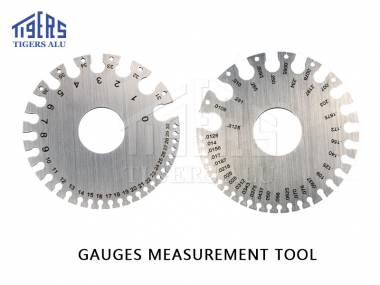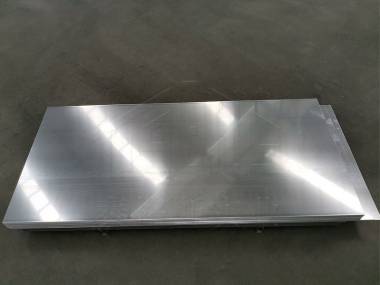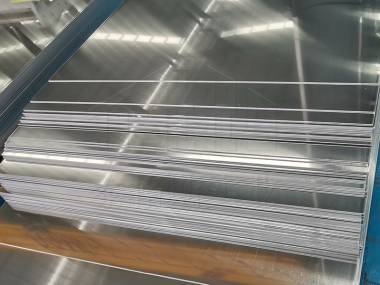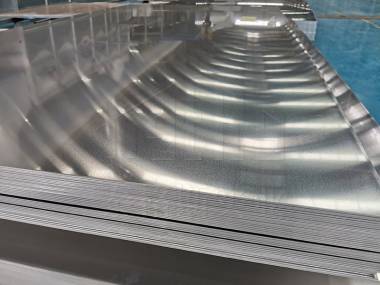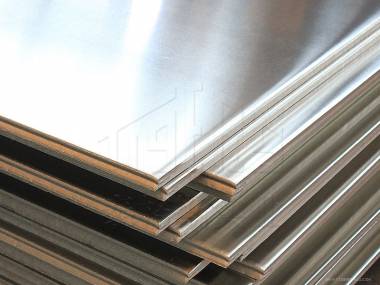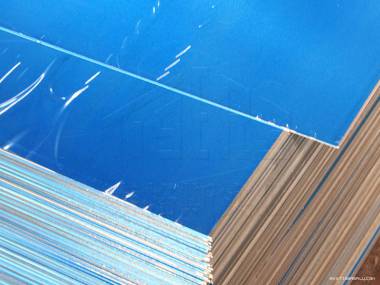What is the difference in aluminum sheet and aluminum plate?
What is the aluminium plate and what is aluminium sheet?
Some people call aluminium sheets to aluminum plates, they are essentially the same, but there are actually some differences between the two products.
Aluminum plate and aluminum sheet are both flat-rolled products made from aluminum, differing primarily in thickness, which influences their applications and properties – with plate being thickest and sheet the thinner.
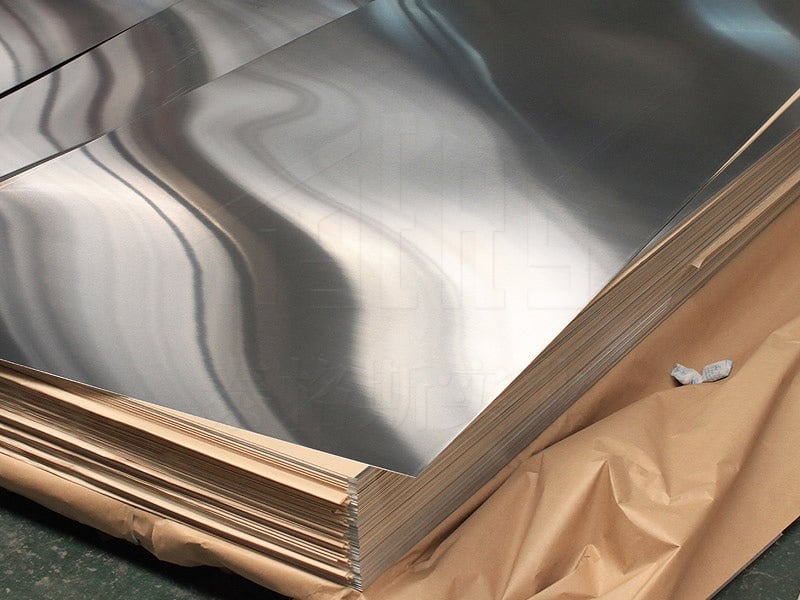
aluminum sheet interleaved with paper
Thickness Distinctions
- Aluminum Sheet: Typically ranges from 0.2 mm up to 6 mm in thickness.
- Aluminum Plate: Defined as aluminum material thicker than 6 mm.
- Aluminum Foil: Thinner than 0.2 mm, used for applications requiring flexibility and barrier properties.
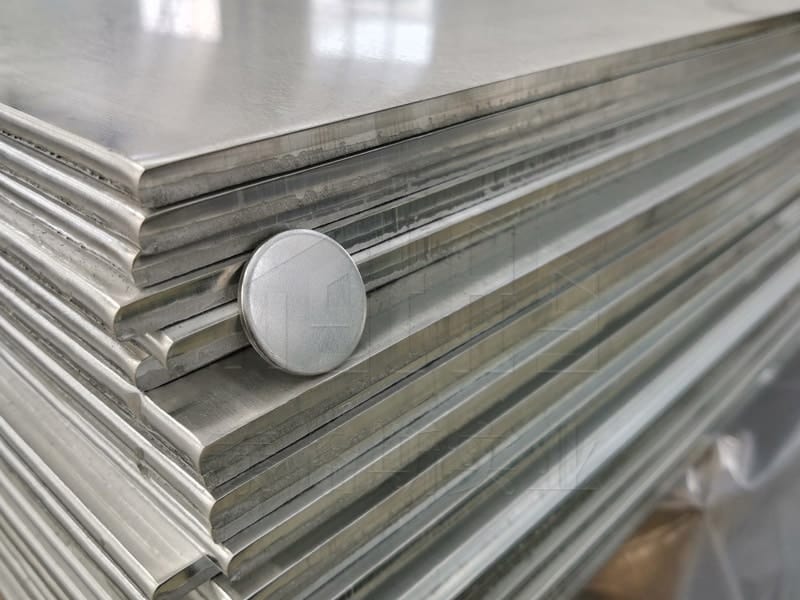
8mm 5005 h32 aluminum plate
Applications
Due to their superior physical properties, aluminium sheet and plate are sought after for many different industrial applications.
- Aluminium plate is used for heavy-duty and structural applications, such as aerospace, military, and rail and sea transportation.
- Aluminium sheet is the most common form of the metal, and is used in a wide range of industries, from food & beverage canning to cookware, appliance, and auto manufacturing. It is especially useful for construction of roofing, gutters, and siding.
Aluminum sheet or plate is used in various applications, including aerospace, military, transportation, etc. Aluminum sheet or plate is also used for tanks in many food industries, because some aluminum alloys become tougher at low temperatures.
You can see aluminum sheets utilized for packaging by the food ,Aluminium foil in flexible food packaging and beverage industry, and as parts of cookware and appliances. Sheets of this metal can also be seen being used by the construction and housing industry in the form of roofing, gutters, sidings and the like.
| Type | Application |
| Food Packaging | Beverage can end, can tap, cap stock, etc. |
| Construction | Curtain walls, cladding, ceiling, heat insulation and venetian blind block, etc. |
| Transportation | Automobile parts, bus bodies, aviation and shipbuilding and air cargo containers, etc. |
| Electronic Appliance | Electrical appliances, telecommunication equipment, PC board drilling guide sheets, lighting and heat radiating materials, etc. |
| Consumer Goods | Parasols and umbrellas, cooking utensils, sports equipment, etc. |
| Other | Military, color coated aluminum sheet |
- Aluminum Sheet: Due to its moderate thickness, it’s widely used in:
- Construction: Roofing, siding, and gutters.
- Automotive: Body panels and decorative trims.
- Packaging: Beverage cans and food containers.
- Appliances: Cookware and household items.
- Aluminum Plate: Its greater thickness makes it suitable for:
- Aerospace: Structural components and aircraft skins.
- Marine: Shipbuilding and offshore structures.
- Military: Armor plating and defense equipment.
- Industrial: Heavy-duty machinery and tooling.
Summary Table
| Category | Thickness Range | Common Uses |
| Aluminum Foil | < 0.2 mm | Packaging, insulation, cooking wraps |
| Aluminum Sheet | 0.2 – 6 mm | Construction, automotive, packaging, appliances |
| Aluminum Plate | > 6 mm | Aerospace, marine, military, industrial machinery |
Understanding the distinction between aluminum sheet and plate is crucial for selecting the appropriate material for your specific application, ensuring optimal performance and cost-effectiveness.
The thickness of aluminium plate and aluminium sheet are different:
Aluminium plate refers to aluminium material with a thickness of more than 5mm to less than 500mm, a width of more than 200mm.
Aluminium sheet thickness is less than 5mm.
The exact thicknesses separating the categories depend upon the application, the metal in question, the gauge, and product specifications.
aluminium foil
Thinner than aluminum plate is called aluminum foil.
When choosing between the three types of products, the only difference is the thickness – with plate being thickest and foil the thinnest.
Why aluminum and aluminium?
Aluminum and aluminium are two names for element 13 on the periodic table. In both cases, the element symbol is Al, although Americans and Canadians spell and pronounce the name aluminum, while the British (and most of the rest of the world) use the spelling and pronunciation of aluminium.
And so we land today: with aluminum used by the English speakers of North America, and aluminium used everywhere else.
Aluminum sheet and aluminum plate are both widely used and respected due to the metal’s light-weight strength, along with high corrosion resistance. But what is the difference between sheet, plate, and foil?
Difference in grades :
Our aluminum plate is available in a variety of alloys and various weights and thickness. Popular grades include 6061 plate, 6082 plate, 5052 sheets, and 7075 aluminum.
Selecting the right grade of aluminum plate depends on its intended use. The 5052 plate offers excellent corrosion resistance and weldability while 6061 aluminum plate is one of the strongest and most commonly used heat treatable
grades.
Additional available grades include 1050, 1060, 1100, 3003, 3004, 5005, 5052, 5083, 5754, 6061, 6063, 6082, 7075 etc.
Many different forms of aluminum sheet and plate:
Aluminium sheets or plates comes in many forms including diamond plate, aluminum tread checker plate, expanded, perforated aluminum sheet, painted aluminum sheet and aluminum veneer panel.
